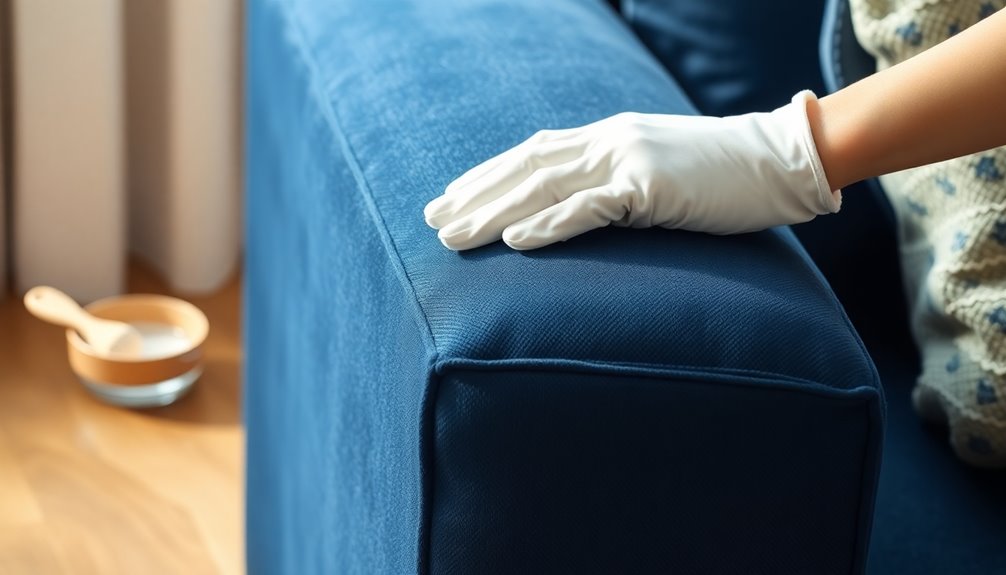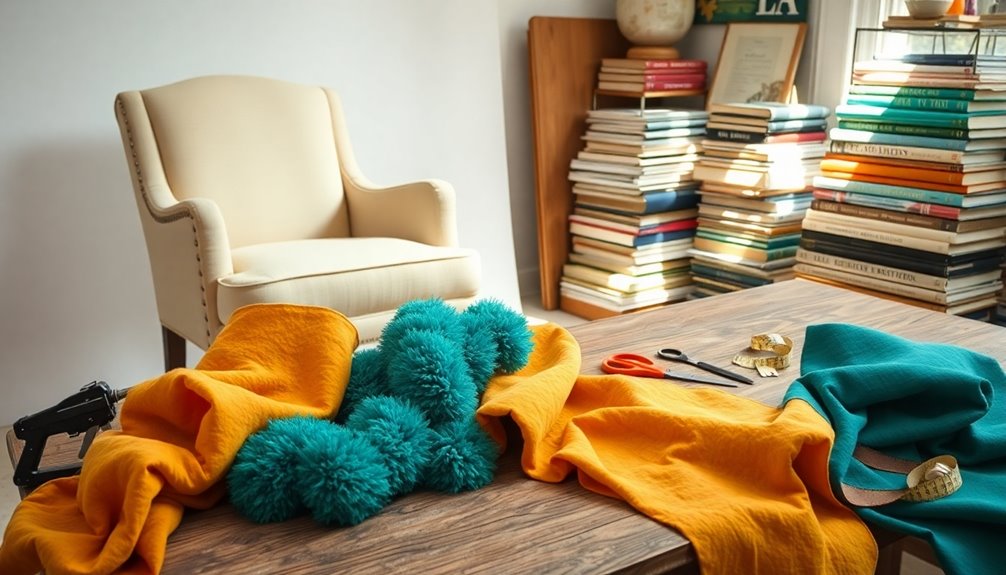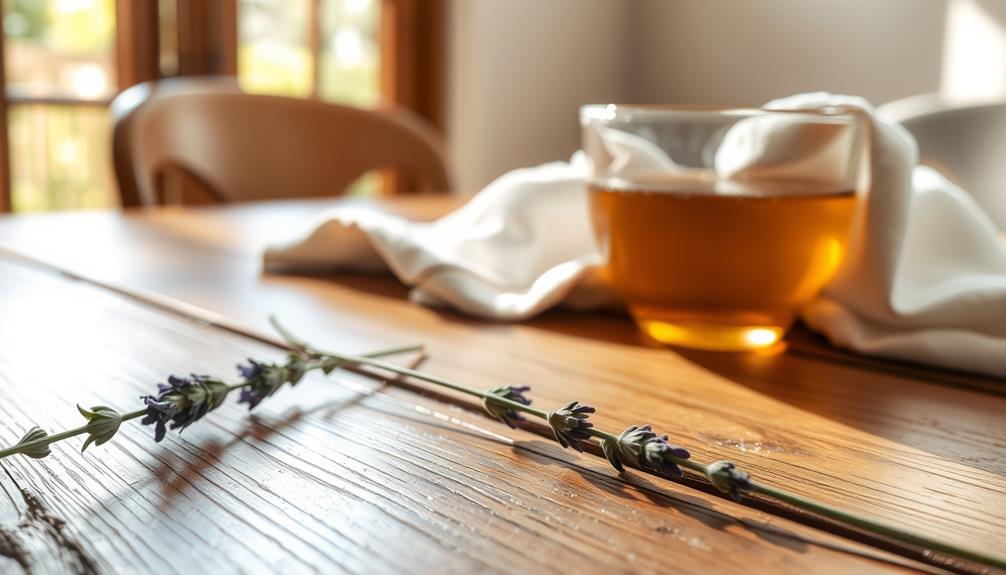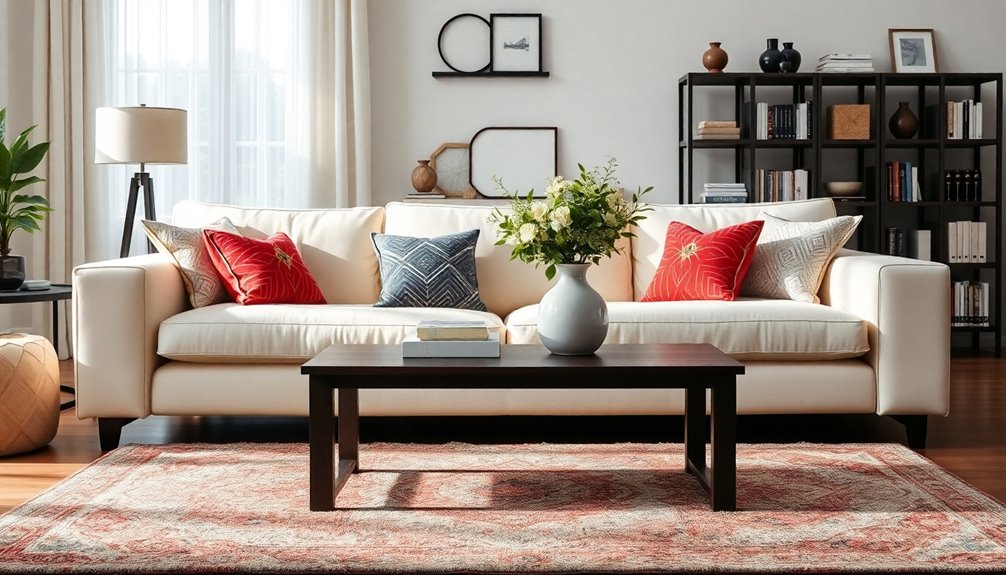To clean your sofa arms, start by checking the care label for specific cleaning codes. If your upholstery is water-safe, mix a mild detergent with water for a gentle scrub. For solvent-based fabrics, use a dry-cleaning agent. Blot any stains promptly and test any cleaning solution on a hidden area first. Regular vacuuming helps prevent dirt buildup, while adding arm guards can protect against scratches and spills in the future. Keeping your sofa's fabric in good shape enhances its lifespan and appearance. For more tips on maintaining your furniture's beauty, keep exploring effective cleaning strategies.
Key Takeaways
- Check the care label for cleaning codes to determine the appropriate cleaning method for your sofa arms.
- Use a damp cloth with a suitable cleaner for the fabric type; test on a hidden area first.
- Blot stains immediately and apply a mild detergent solution for effective stain removal on water-safe fabrics.
- Consider using arm guards for added protection against scratches and spills, which can be easily washed.
- Regularly vacuum sofa arms to remove dust and debris, prolonging the upholstery's lifespan and maintaining cleanliness.
Introduction
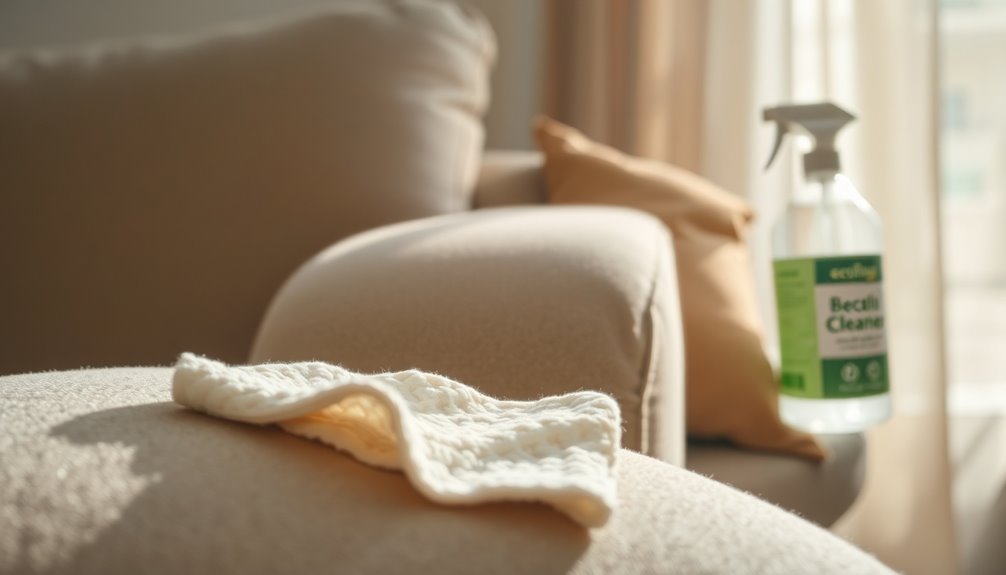
Keeping your sofa arms clean is essential for maintaining their look and hygiene. You'll want to start with routine dusting and vacuuming, then explore fabric-specific cleaning techniques to tackle tougher stains like wine and grease. With the right approach, you can ensure your sofa arms stay fresh and inviting.
Routine Dusting and Vacuuming
Regularly dusting and vacuuming your sofa arms is essential for maintaining a clean and inviting living space. These routine cleaning practices help remove loose dirt, dust, and debris that accumulate from daily use. Not only does this enhance the overall cleanliness of your sofa, but it also improves indoor air quality by reducing allergens like dust mites.
To effectively clean your sofa arms, use a vacuum cleaner with an upholstery attachment. This tool allows you to thoroughly clean the arms and reach crevices where dirt and pet hair often hide. Aim to vacuum the sofa arms at least once a week to prevent dirt buildup and prolong the lifespan of your upholstery.
In addition to vacuuming, you might find that a lint roller is a quick and effective way to remove pet hair and small debris between your deep cleaning sessions. By incorporating these simple steps into your cleaning schedule, you'll not only keep your sofa looking great but also create a healthier environment in your home. So, grab your vacuum cleaner and start tackling those dust bunnies today!
Fabric-Specific Cleaning Techniques
When it comes to cleaning sofa arms, understanding the fabric type is crucial. Always check the care label for cleaning codes like W (water), S (solvent), WS (both), or X (vacuum only) to guide your approach. For water-safe fabrics (W or WS), mix mild detergent with water to create effective cleaning solutions. Gently apply it to clean sofa arms, but avoid over-wetting.
If your sofa arms are made of solvent-based fabric (S), you'll need dry-cleaning agents. Use a soft cloth to apply the solution carefully, and remember to perform a spot test first to avoid damage. Microfiber sofas can benefit from a mixture of water and vinegar. Just blot the stain instead of scrubbing to preserve the fabric's integrity.
For leather sofa arms, a damp cloth works wonders. Follow that up with a specialized leather cleaner and conditioner to prevent drying or cracking, keeping your sofa looking its best. By tailoring your cleaning techniques to the specific fabric, you ensure that your sofa arms remain in top condition for years to come.
Targeting Wine and Grease
Wine and grease stains often sneak up on you, but tackling them doesn't have to be a daunting task. If you find a wine stain on your sofa arms, start by blotting the area with a clean cloth to absorb as much liquid as possible. Next, mix one part dish soap with two parts hydrogen peroxide and apply this solution to the stain. Let it sit for about 30 minutes before rinsing it with a damp cloth. This method works wonders on upholstery without causing damage.
For grease stains, sprinkle baking soda over the affected area to absorb the oil, and let it sit for 15-20 minutes. Afterward, vacuum it up, then clean the area with a mild detergent solution for a thorough finish. Always remember to perform a spot test on a hidden section of your fabric before applying any cleaning solution to avoid discoloration.
Using a soft-bristled brush can help lift those stubborn wine or grease stains from fabric fibers. Regular cleaning and immediate treatment of spills can prevent these stains from setting in, ensuring your sofa arms look great for years to come. Additionally, maintaining regular vacuuming of your upholstery can help remove dirt and allergens, enhancing the longevity of your sofa.
Sofa Arm Guards for Protection
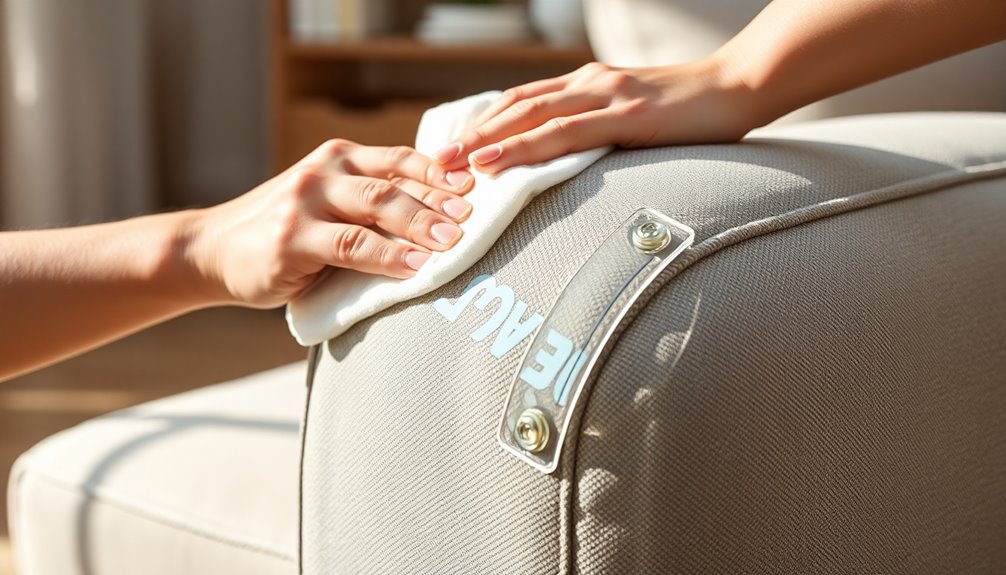
If you want to keep your sofa arms looking new, consider using arm guards for protection. These covers can prevent scratches from pets and protect against spills, making them a smart addition. Plus, you can choose from various materials and styles to match your home decor while ensuring easy maintenance.
Scratching Post Integration
Integrating scratching posts with sofa arm guards is a smart way to protect your furniture while catering to your cat's natural scratching instincts. By installing these guards, you can effectively shield your sofa arms from wear and tear, reducing the need for frequent cleaning and repairs. Made from durable materials like sisal or fabric, these arm guards serve as a barrier against your pet's claws.
When you place scratching posts near your furniture, you encourage your cat to use them instead of the actual sofa arms. This not only protects your sofa but also promotes better furniture maintenance and hygiene in your home. Many arm guards come with adhesive backing or Velcro straps, making installation and removal a breeze. If your pet does scratch the guards, you can easily clean or replace them without hassle.
Incorporating this dual-purpose solution into your home can save you time and effort in the long run, keeping your sofa looking great while satisfying your pet's instincts. With the right setup, you can enjoy a scratch-free sofa and a happy, engaged pet.
Fabric Protectors for Sofa Arms
Protecting your sofa arms from everyday wear and tear is essential for maintaining their appearance and longevity. Fabric protectors like sofa arm guards can be a game-changer. These products are designed to shield your upholstery against stains, spills, and general wear, helping to prolong the life of your sofa. Many arm guards are crafted from durable, washable materials that you can easily remove and clean, keeping your sofa looking fresh over time.
Additionally, applying a fabric protector spray can create a protective barrier against liquid and oil-based stains, allowing you to clean up spills before they set in. Some sofa arm guards even come with added features such as non-slip backing or adjustable straps, ensuring they stay securely in place during use. Regularly using fabric protectors not only enhances the durability of your sofa arms but also contributes to a healthier home environment by reducing allergens and bacteria accumulation.
Moreover, incorporating regular dental visits into your health maintenance routine can help improve your overall well-being. By implementing these cleaning techniques, you'll keep your sofa in top condition and ready for years of comfort. Protect those sofa arms, and enjoy a pristine living space!
Using Arm Covers
Sofa arm covers, also known as arm guards, offer an effective solution for shielding your furniture from everyday damage. These covers protect your sofa's arms from stains, wear, and tear, extending its lifespan significantly. They're typically made from durable, washable materials, so you can easily clean and maintain them, keeping your sofa looking clean and fresh.
Most sofa arm covers feature elastic or adjustable straps, ensuring a snug fit that prevents slipping during use. This means you can relax without worrying about them moving around. Plus, available in various colors and patterns, these covers not only provide protection but also enhance your furniture's aesthetic appeal.
Using sofa arm covers can significantly reduce the need for frequent cleaning of the sofa arms. By creating a barrier against spills and dirt, they simplify your cleaning routine, making it easier to maintain hygiene in your living space. Additionally, investing in protective covers can lead to extended lifespan of your furniture, which is critical for maintaining its value. With less effort spent on cleaning, you can enjoy your sofa more, knowing it's protected. So, consider investing in sofa arm covers for a practical and stylish solution to keep your furniture looking its best.
Upholstery Stitching Reinforcement
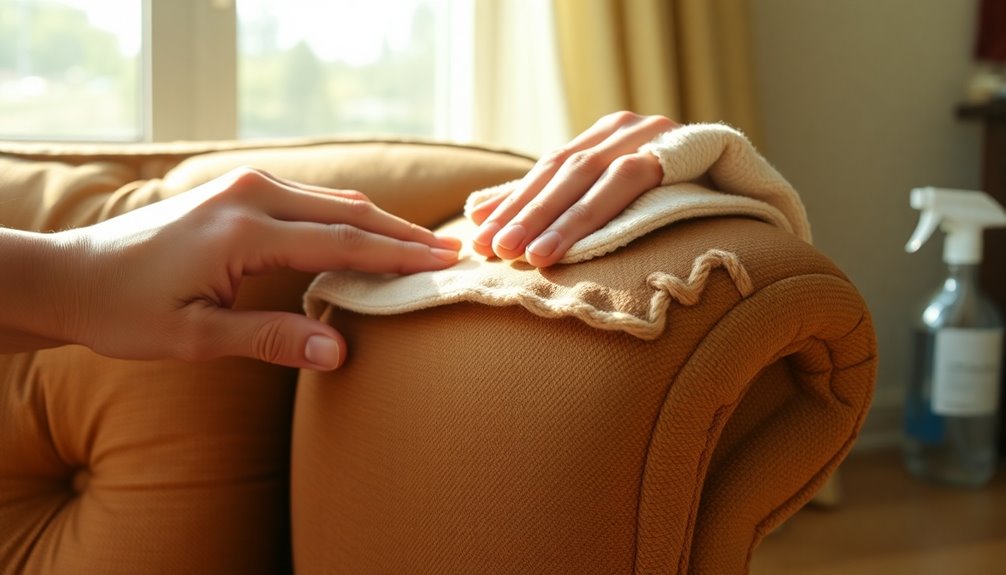
When you inspect your sofa arms, pay close attention to any weak seams and stitching. Strengthening these areas not only revitalizes the fabric or leather but also enhances the overall texture of your upholstery. By addressing these issues promptly, you can ensure your sofa remains durable and visually appealing for years to come.
Weak Seams and Stitching
Frequent use of sofa arms can lead to weak seams and stitching that may eventually cause fabric fraying and separation. To prevent this, it's crucial to regularly inspect the seams for any signs of wear. If you notice weak seams, consider reinforcing the upholstery stitching. Techniques like backstitching or using a heavier thread can significantly enhance durability in these high-stress areas.
If you have a sewing machine, opt for a zigzag stitch; it adds extra strength to seams, especially on fabrics that stretch or pull. When making repairs, ensure that any thread and material match the original to maintain your sofa's aesthetic and integrity.
Another key factor is regular cleaning. Dirt and grime can accumulate over time, potentially compromising the quality of your stitching. By keeping the sofa arms clean, you'll not only improve their appearance but also help prolong the life of the upholstery. So, make it a point to clean your sofa arms regularly and address any weak seams promptly. This proactive approach will ensure your sofa remains both beautiful and functional for years to come.
Fabric and Leather Revitalization
Maintaining the appearance and longevity of your upholstery hinges on effective fabric and leather revitalization. One crucial aspect is upholstery stitching reinforcement, especially for sofa arms that endure daily use. Regularly inspecting the stitching can help you catch frayed or loose threads before they lead to more significant issues, like fabric unraveling.
When reinforcing seams, opt for heavy-duty thread and a robust needle. This ensures your fabric upholstery can withstand the stresses of everyday use. For leather sofas, you'll need specialized leather needles and threads to avoid damaging the material. This attention to detail will maintain the integrity of your sofa arms while preserving their aesthetic appeal.
If you're unsure about your skills, consider hiring a professional upholstery service. They can provide expert reinforcement techniques that match your sofa's original style, ensuring both durability and beauty. Incorporating these cleaning methods into your upholstery care routine will not only enhance the lifespan of your furniture but also keep it looking fresh and inviting. Remember, the effort you put into upholstery stitching reinforcement pays off in the long run!
Revitalized Upholstery Texture
Revitalizing upholstery texture involves paying close attention to the condition of the stitching on your sofa arms. Regularly cleaning your sofa not only removes dirt but also helps maintain the integrity of upholstery stitching. When you neglect this, fraying and wear can occur over time.
Use the right cleaning method based on your fabric type; for instance, "W" coded fabrics can handle water, which preserves the texture and structure of the upholstery stitching. Always start by thoroughly vacuuming the sofa arms to eliminate debris that could snag or pull on the stitching during cleaning.
When it's time to clean, avoid excessive moisture that can weaken the stitching. Instead, opt for a lightly damp cloth to gently wipe surfaces, keeping them fresh without compromising the fabric.
After cleaning, applying fabric protectants can reinforce the upholstery stitching, creating a barrier against dirt and stains. This simple step helps prolong the lifespan of your sofa. By focusing on these details, you ensure your upholstery remains vibrant and resilient, maintaining its beauty and functionality for years to come.
Personalized Fabric Choices
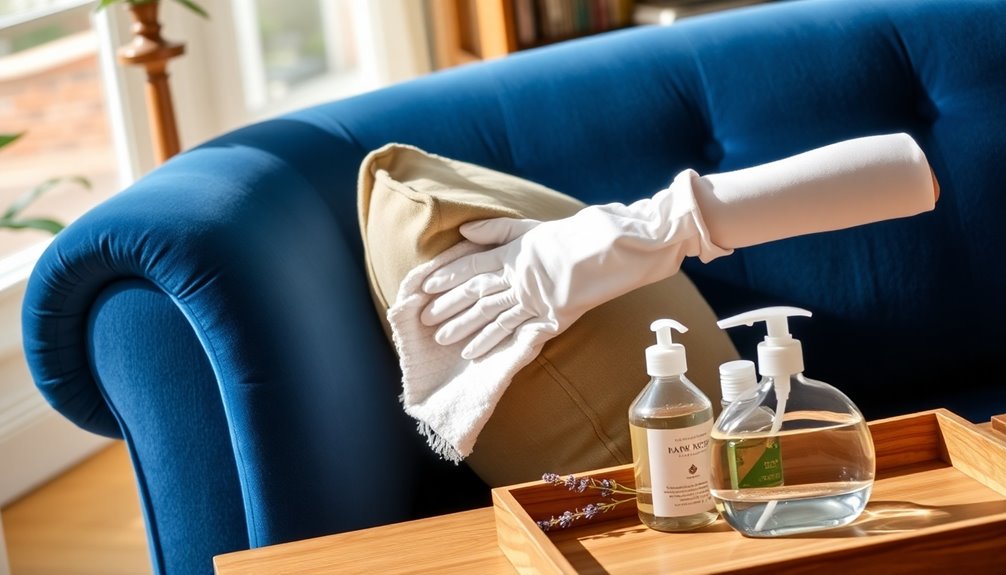
When choosing fabric for your sofa arms, it's essential to consider how each material fits your lifestyle and aesthetic preferences. Microfiber is a fantastic option if you're looking for durability and ease of cleaning. It's stain-resistant and perfect for high-traffic areas, making it ideal for busy households. If comfort is your priority, cotton blends can provide breathability but may require more frequent cleaning to keep them looking fresh and stain-free.
Leather adds a touch of elegance and is easy to wipe down, but it does need specialized care to prevent drying and cracking. If you want to create a luxurious feel, velvet can be enticing, though it's more susceptible to stains and may need professional cleaning to maintain its look.
For pet owners, choosing fabrics with tight weaves or synthetic fibers can make a significant difference. These materials resist snagging and are easier to clean from pet hair and odors. Prioritize what matters most to you—whether it's durability, style, or ease of maintenance—to find the perfect fabric for your sofa arms.
Preventing Sun Damage
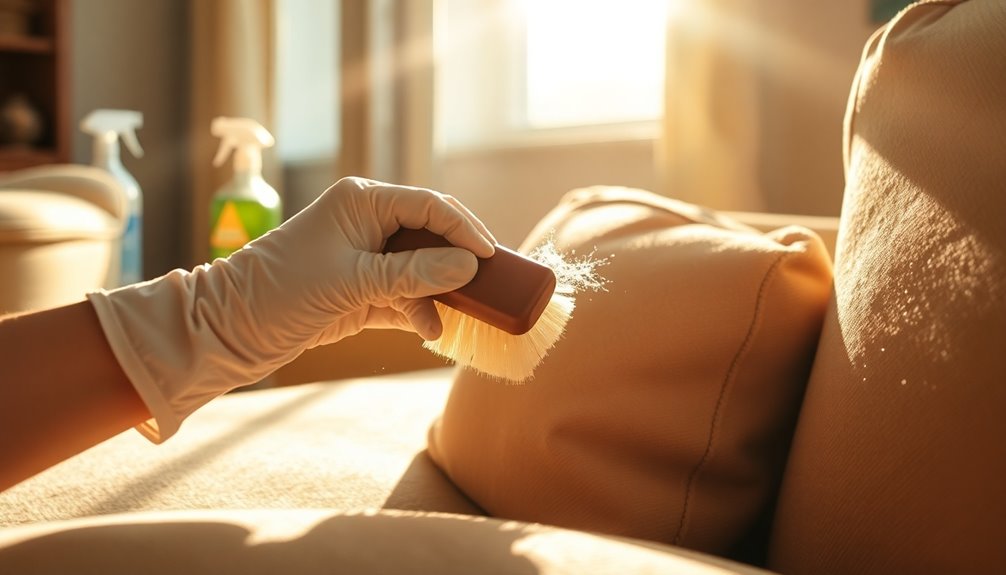
Sun damage can quickly fade and deteriorate your sofa arms, but there are several effective strategies to protect your investment. Start by positioning your furniture away from direct sunlight. If that's not possible, use window treatments like blinds or curtains to minimize UV exposure. Installing UV-blocking window films can also be a game-changer, reducing harmful rays by up to 99%, which helps keep your upholstery looking fresh.
Additionally, consider using fabric protectants that include UV inhibitors. These products offer an extra layer of defense against sun damage and can significantly prolong the life of your fabric. It's also wise to regularly rotate your cushions and reposition furniture to ensure even exposure to light. This practice helps prevent uneven fading and wear on your sofa arms.
Lastly, maintain a consistent indoor humidity level between 30% and 50%. This prevents the fabric from drying out, making it more resilient against sunlight damage. By following these strategies for preventing sun damage, you'll help keep your sofa arms looking vibrant and new for years to come.
Conclusion
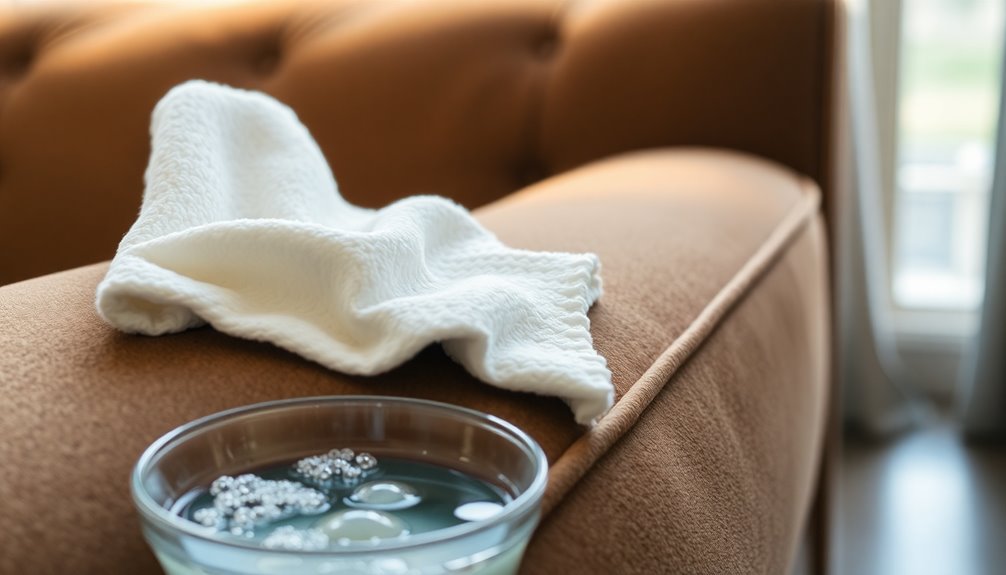
Cleaning your sofa arms is essential for maintaining not just their appearance but also the hygiene of your entire living space. By regularly cleaning them, you prevent the buildup of dirt, dust, and bacteria that can affect overall cleanliness. To achieve the best results, understand the fabric type and always follow the manufacturer's instructions. This knowledge helps avoid damage during the cleaning process.
Start with some solid cleaning tips: use a vacuum with an upholstery attachment to remove loose debris before applying any cleaning solutions. For stubborn stains, a gentle blotting technique with a mild detergent solution or a vinegar-water mixture can lift blemishes effectively without harming the fabric.
Regular maintenance, like vacuuming and applying fabric protectants, is crucial in extending the lifespan of your sofa arms and keeping them looking new longer. Remember, consistency is key. Incorporating these cleaning habits into your routine not only enhances the appearance of your sofa but also contributes to a healthier living environment. So grab those cleaning supplies and give your sofa arms the attention they deserve!
Frequently Asked Questions
How Do You Clean Fabric Chair Arms?
To clean fabric chair arms, start by checking the care tag for cleaning instructions. Vacuum the arms using an upholstery attachment to remove dust and debris. For stains, mix 2 cups of distilled water with 1 tablespoon each of mild dish soap and white vinegar. Dampen a microfiber cloth with the solution and blot the stain. Rinse with a clean cloth dampened in distilled water, then blot dry to prevent moisture buildup.
How to Get Smell Out of Couch Arm?
To get the smell out of your couch arm, start by sprinkling baking soda over the fabric and letting it sit for 20 to 60 minutes. This helps absorb unwanted odors. For a more focused approach, mix equal parts water and white vinegar in a spray bottle, lightly mist the area, and blot with a clean cloth. Regularly using a fabric freshening spray can also keep your couch smelling fresh between deep cleanings.
What Is the Best Thing to Clean a Fabric Sofa With?
When you’re looking to clean a fabric sofa, the best solution is a mix of 2 cups of distilled water, 1 tablespoon of dish soap, and 1 tablespoon of vinegar. This combination effectively tackles stains without harming the fabric. Always spot test in an inconspicuous area first. Use a damp microfiber cloth to gently blot stains instead of scrubbing, which can damage the fibers. Regular vacuuming also keeps your sofa looking fresh. Additionally, to maintain the overall appearance of your sofa, it’s important to not only clean the fabric but also to consider how to refresh sofa pillows. Fluffing them regularly and using a fabric freshener can revitalize their look and feel. If they become too stained or worn, removable covers can often be washed, giving your entire seating area a renewed, inviting aesthetic.
How Do You Clean the Arms of a Microfiber Couch?
To clean the arms of your microfiber couch, start by vacuuming them with an upholstery attachment to remove dirt. Next, mix 2 cups of distilled water, 1 tablespoon of dish soap, and 1 tablespoon of white vinegar. Dampen a microfiber cloth with this solution and blot any stains. Gently scrub with a soft-bristled brush, rinse with distilled water, and blot dry. For freshness, sprinkle baking soda occasionally before vacuuming it off.
